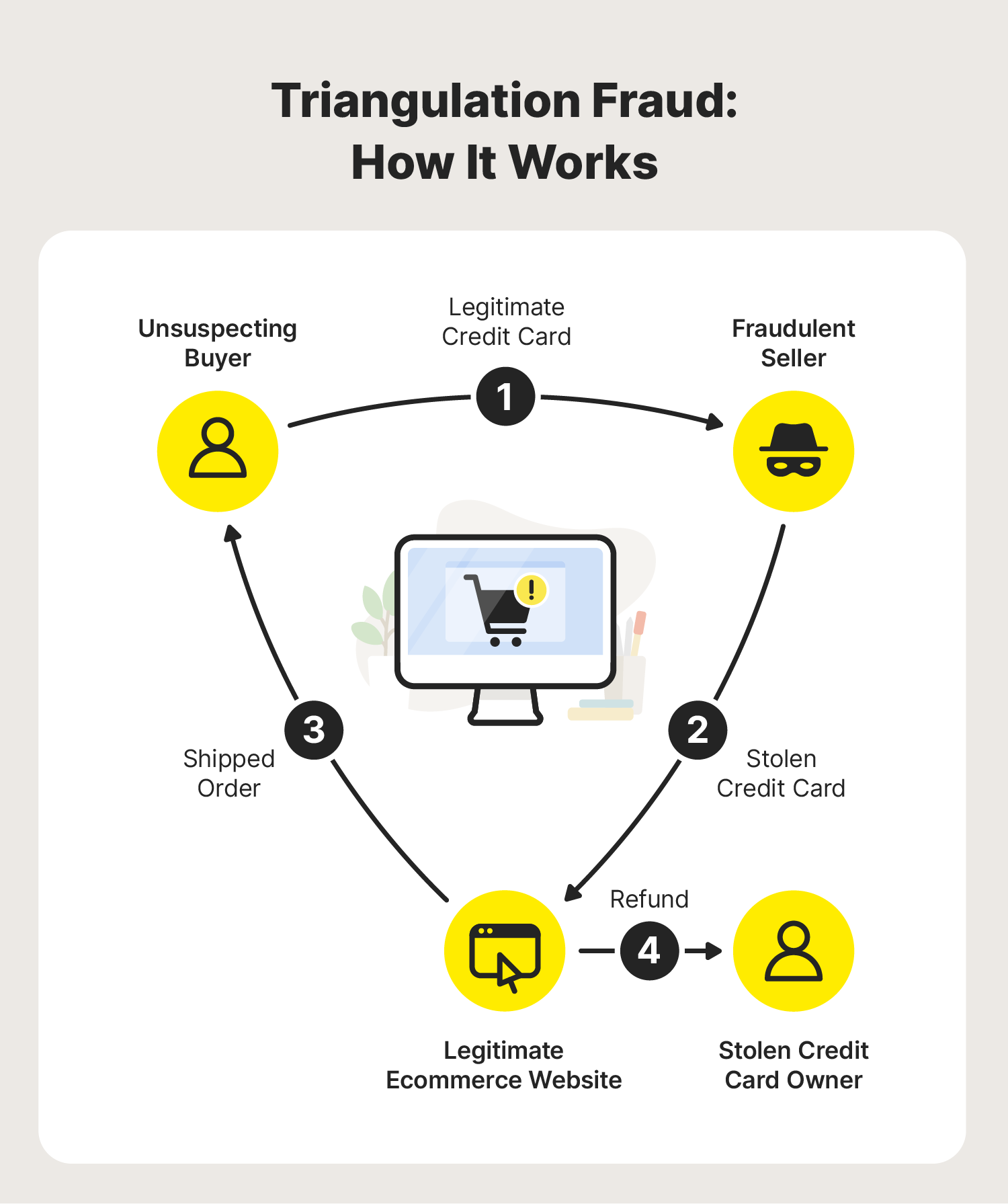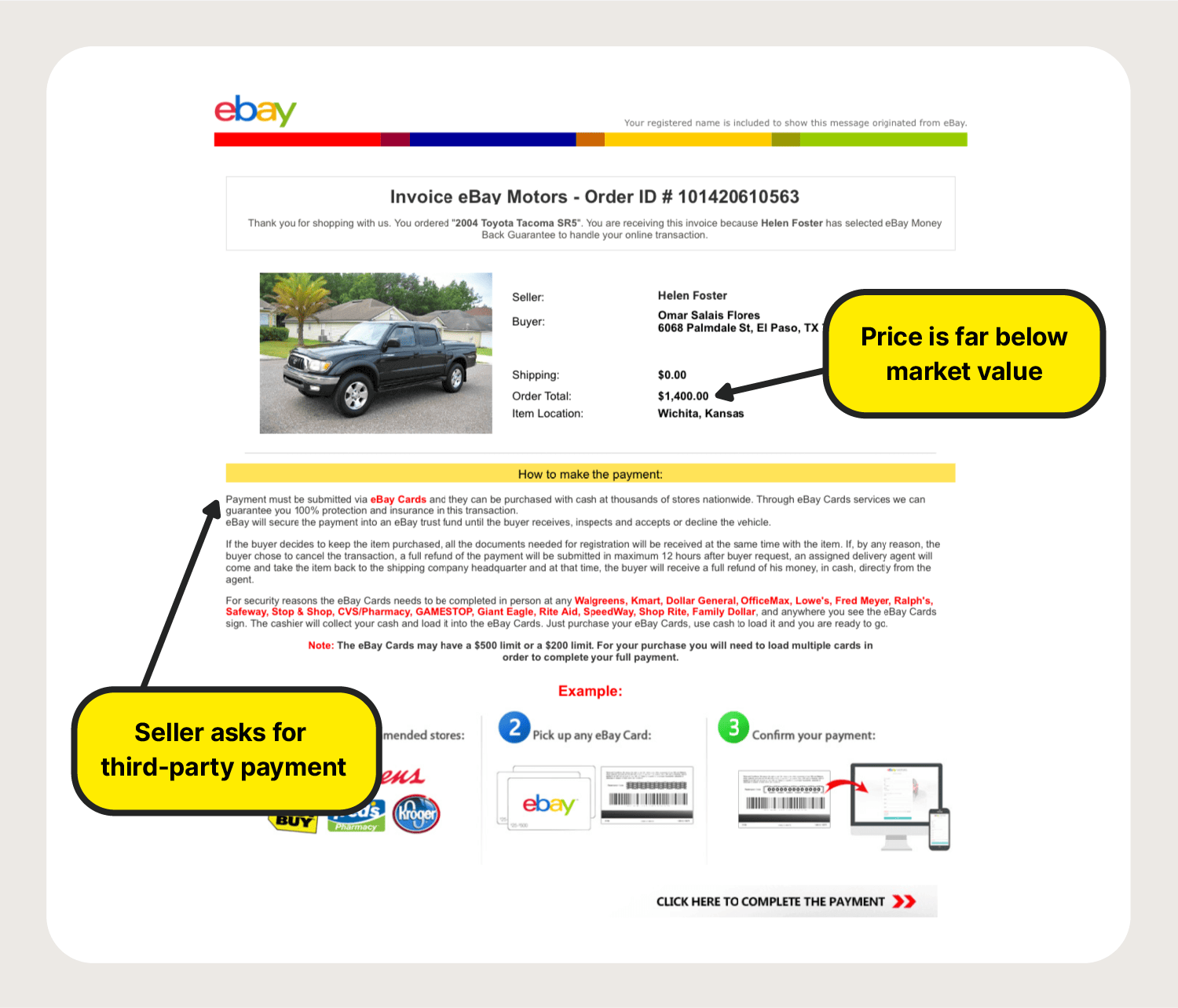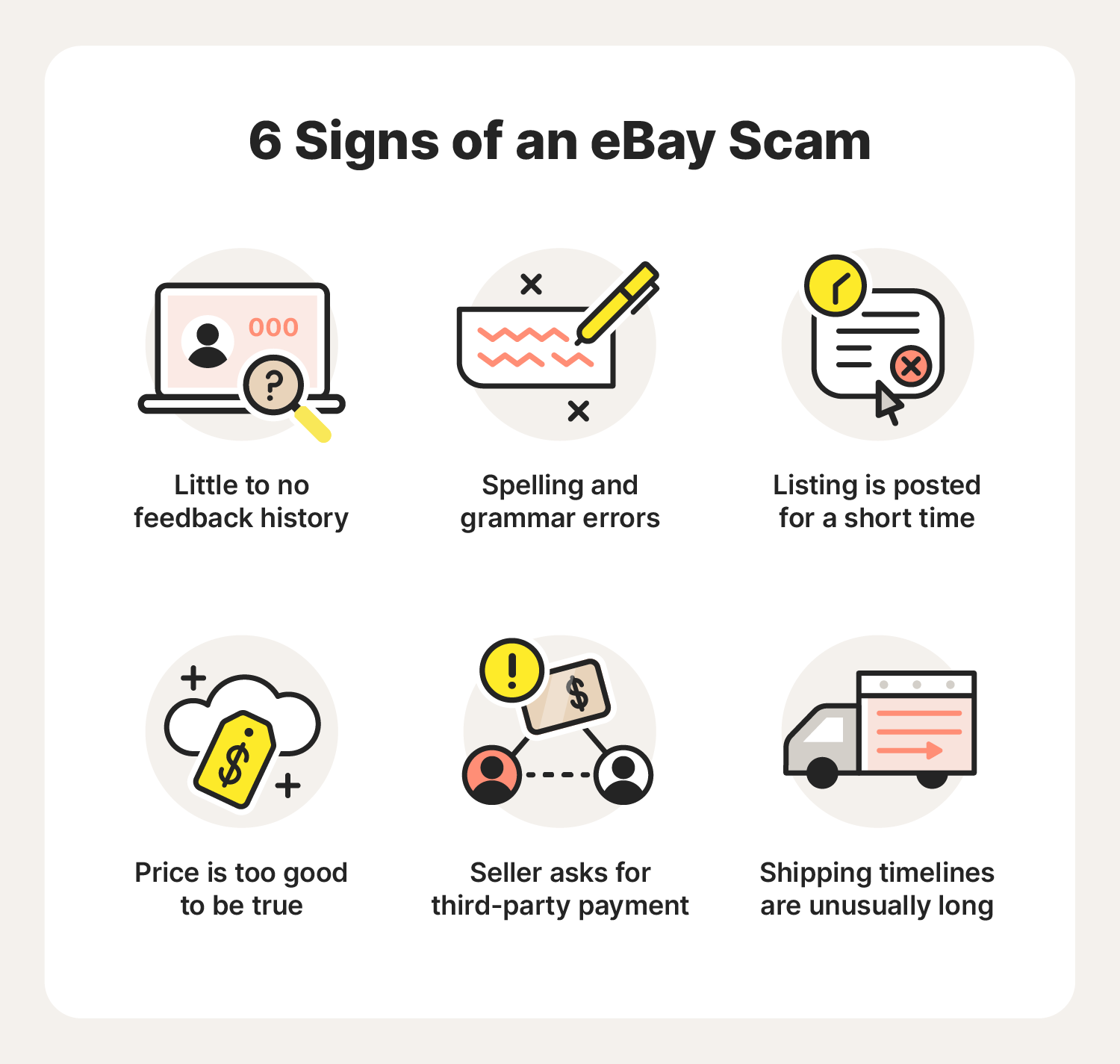Don’t fall for eBay scams: 15 common scams and how to spot them
From vintage clothing to guinea pig battle armor, eBay is the go-to shop for many people looking for one-of-a-kind items or bargains. But its popularity means scammers and cybercriminals also lurk there. Learn about 15 common scams you might encounter on eBay, how to avoid them, and how to stay safer online with robust online security software like Norton 360 Deluxe, which includes powerful anti-scam features to help you stay safe.

1. Phishing scams
A phishing scam on eBay is when you receive an email that looks like a legitimate eBay email but either hides malware or tries to trick you into sharing personal information. A hacker could also include a link to a fake eBay site to achieve similar aims.
What we don’t always consider is that websites are full of little design choices. A normal site responds visually when you enter something, but on a fake e-shop it may look like nothing is happening. That is just one way a website can feel “off”, compelling you to click again and again, which can make things worse.
Always go to the legitimate eBay site by typing eBay.com manually into your address bar. Never correspond via email; instead, go directly to eBay and read your messages there. Familiarize yourself with the ways to avoid phishing, including the most helpful lesson: never click unfamiliar links in emails or text messages.
2. Refund scams
A refund scam is when a buyer misuses eBay’s refund process to scam a seller out of their item and money. Normally, a refund requires the item to be returned first, and eBay uses the tracking barcode to verify that the return happened. In this scam, the buyer covertly changes the address, and eBay may miss this.
When the barcode gets scanned in the seller’s zip code, eBay is notified that the item has been returned. In reality, the shipping label was made out for another address in that zip code and the box was probably empty.
3. Non-delivery scams
A non-delivery scam is when an item you paid for isn’t delivered. There is a process for reporting undelivered items, and it usually involves tracking numbers and shipping notifications. But some scammers have figured out that digital purchases can’t be refunded this way because they are never physically delivered.
Furthermore, digital content purchased on eBay isn’t covered by the company’s money-back guarantee. Fraudsters can accept your payment and disappear without any way of getting your money back through eBay.
To avoid this scam, be especially careful when it comes to intangible goods and services, including:
- Websites or businesses for sale
- Digital content
- Non-fungible tokens (NFTs)
- Travel tickets or vouchers
- Travel tickets or vouchers
- Industrial equipment and heavy machinery
- Classified ads
- Real estate
- Motor vehicles
eBay offers sellers the freedom to list their items freely, but this also puts the onus on buyers to avoid non-delivery scams. Be cautious when purchasing items or services not covered by eBay's money-back guarantee. Always read reviews and feedback, and be wary if other users have reported scams.
4. Incorrect label scams
An incorrect label scam involves a seller intentionally putting wrong information on the shipping label in order to keep both the item and the buyer's money. The seller ships the item to the buyer's correct address but with a different name. When the buyer sees the incorrect name, they often return the package, thinking it's a mistake.
The seller then claims the item was “refused” or “returned”, allowing them to keep the product and the payment. This scam leaves the buyer with no way to dispute the transaction once it's marked as finalized.
Here are some tips on how to avoid an incorrect label scam:
- Check your tracking information: If the package you were expecting has been delivered according to the tracking info, it’s a good indication it’s yours, despite the name on the label.
- Check the weight of the package: Compare the weight of the package with the weight of the tracking information. If the weights are comparable, it’s likely your package. Be sure to take a photo of the shipping label and package before you open it.
- Consider the shipping method: If the seller has selected an unfamiliar shipping option or service, proceed with caution.
5. Empty box scams
An empty box scam occurs when you think you’re buying an item but receive only an empty product box. To avoid this, read the entire listing carefully and scrutinize the seller's profile. Sometimes the label “EMPTY BOX ONLY” is hidden at the end of the product title.
Additionally, check if the seller's account is new, as this can be a red flag. While there is a legitimate market for items like empty PlayStation 5 boxes, these listings should be clearly marked to avoid confusion.
If you receive an empty box when you thought you were getting something else, here’s how you can potentially rectify this scam:
- Photograph the unopened box on a scale showing its weight.
- Take a video recording of the box being opened.
- Click on Return Item next to the item in your purchase history.
- Specify issues with the item that were not as described.
- Ask the post office to provide you with the weight they recorded when they processed the package. That information should be on a note that’s signed and dated, and it might come in handy if you need further proof.
eBay’s automated process may not let you try again if you make a mistake filling it out. If you get to the appeal stage, be sure you provide them with strong evidence and clear pictures.
6. Triangulation fraud
Triangulation fraud is a complex eBay scam that’s particularly hard to spot. This scam uses stolen credit cards to exploit unsuspecting targets. Here’s how it works:
- An eBay buyer makes a purchase unknowingly from a fraudulent seller on eBay.
- The fraudulent seller uses a stolen credit card to pay for the same item from another online store that’s legitimate.
- The legitimate store sends the product to the eBay buyer.
- The stolen credit card owner disputes the charge, resulting in a chargeback and the legitimate store loses the money. Meanwhile, the fraudster keeps the money from the buyer.


7. Third-party payment scams
A third-party payment scam is when a seller requests you pay for an eBay item through another platform like Venmo or PayPal (not via eBay). These payments are made outside of eBay, so the company isn’t responsible for them and can’t assist with them.
eBay links payments to product listings, ensuring accountability and simplifying returns. In contrast, if you make a payment outside of eBay on a platform like Venmo or PayPal, the payment lacks connection to the purchase history or shipping labels, making disputes difficult. Scammers exploit this by urging buyers to use these platforms, securing payment without delivering the product.
If you’ve fallen for this type of scam, contact the Venmo scams department or PayPal scams department as well as eBay, even though eBay may not be able to help.
8. Customer service scams
A customer service scam involves someone posing as an official support agent in order to steal your information. Avoid this by never sharing personal details like full credit card numbers or passwords. It's usually safe to give non-sensitive info, like the last four digits of your credit card or tracking numbers, but legitimate customer service support agents will never ask for your password.
How else can you tell a scammer from a real customer service agent? Whereas legitimate eBay customer service staff will be polite and professional, a scammer might:
- Be pushy or urgent
- Make you feel like something is wrong
- Ask for your whole credit card number or password
- Request scans or photos of your face or IDs
9. Gift card scams
Gift card scams on eBay start with a seller asking you to pay with a gift card—they may contact you outside of eBay via social media, email, or phone. Once you share your gift card code, you won’t hear from the fake seller again. To avoid these scams, never share your gift card code and only redeem your gift card on eBay’s website at checkout.
10. Chargeback scams
A chargeback scam occurs when a buyer disputes a charge with their bank or credit card company, resulting in a refund taken from the seller’s account. This process can be initiated simply by claiming the purchase wasn’t made by them or the item wasn’t delivered. To avoid this scam, sellers should limit transactions to trustworthy buyers and scrutinize their profiles and feedback.
11. Broken item scams
A broken item scam happens when a buyer falsely claims an item arrived damaged. To protect yourself, take thorough photos of the item before shipping and record a video of the packing process to show the item was in good condition and properly packaged.
Consider purchasing shipping insurance for valuable items. Then if you suspect fraud, file an insurance claim and ask the buyer to retain the broken item and packaging until an insurance agent can inspect it. This may discourage scammers from pursuing a fraudulent refund claim.
12. Overpayment scams
An overpayment scam occurs when a buyer claims to have “overpaid” accidentally and then asks for a refund of the difference. Then, the initial payment is revealed as fake, or it bounces, leaving you out of pocket. To avoid this scam, be wary of anyone who overpays and never send money back upon request. Instead, tell the buyer to go through eBay’s official refund process.
13. eBay Motors scams
An eBay Motors scam tricks you with a fake vehicle listing and asks for payment through a third-party payment method (off eBay). Buying a car online can be convenient, but the promise of a large purchase also makes you a prime target for scammers.
During an eBay Motors scam, a fraudulent seller creates a fake vehicle listing, which may include:
- A sob story about why they need to sell the car
- A price that’s far below what the car is worth
- A vague vehicle description
- An excuse as to why they can’t sell the car in person
- A request for additional fees
- An offer to handle the shipping process (this is usually handled by the buyer)
- A promise to include eBay Vehicle Purchase Protection
- Spelling and grammar errors
- A request for payment through third-party platforms or unconventional methods (like gift cards)
How to avoid an eBay Motors scam:
- Inspect the car in person or send someone you trust to do so
- Bring someone who knows cars inside and out, if you don’t
- Research how vehicles are bought and sold on the eBay Motors Security Center page, which includes valuable tips and detailed information
- Only pay using a method that’s eligible for the eBay Money Back Guarantee


14. Tracking number scams
A tracking number scam can involve sellers sending a fake package to a different address to falsely prove delivery. This tactic can prevent buyers from receiving refunds under eBay’s seller protection. Another tracking number scam is when scammers send a legitimate tracking number corresponding to a different package, making the buyer think their item was delivered.
Here are a couple of ways to help avoid eBay tracking number scams:
- Read the seller reviews. If several buyers report never receiving their item, it may indicate fraudulent activity. If the seller has zero reviews, be cautious.
- For high-value items, require a signature upon delivery to ensure that the package reaches you.
- Always pay for items directly on the eBay platform.
15. Feedback extortion scams
A feedback extortion scam occurs when a buyer threatens to leave negative feedback unless you provide a discount, add a free item, or cover return shipping costs—none of which were part of the original transaction. If you encounter this, report the buyer to eBay and keep all correspondence as evidence.
How to spot eBay scams
You can help spot scams on eBay by noticing when a buyer or seller’s profile has no history, there are misspellings in a listing, the listing is posted for a short time, a price seems too good, the seller asks for payment off eBay, or shipping timelines are unusually long.


These are also some of the same signs you should look out for to help spot Facebook Marketplace scams and OfferUp scams. Here are more warning signs to look out for if you’re a buyer or seller on eBay:
Buyer fraud
Buyer fraud may sound strange—how can they scam me by sending me money?—but there are several ways buyers can trick sellers and potentially take both your money and your item. Even after receiving payment and sending the item, the transaction isn't over.
Here are some major red flags indicating an eBay buyer scam:
- The buyer asks to pay outside of eBay
- The buyer offers much more than the listed price for an item
- A new buyer purchases a high-ticket item or multiples of the same item
- The buyer asks to change their shipping address to a foreign country
- The buyer requests to make payments for additional shipping after the initial transaction
- The buyer includes a long, detailed description of why they want the item (usually for a family member)
- The buyer is overly eager to complete the sale
- The buyer wants to return the item and use an unfamiliar shipping method
Seller fraud
Seller fraud is easier to understand—the product is fake, it doesn’t exist, or you never see it. Even if you’re aware of this potential fraud, sellers can provide convincing “proof” that can pull the wool over your eyes if you’re not careful.
Here are some possible signs of seller fraud:
- The seller has little or no feedback history
- The item description contains numerous spelling and grammar errors
- The listing is only posted for a short period
- The price for the item is far below market value
- The seller asks for payment off the eBay platform
- The seller only has feedback for low-ticket items, but recently began selling luxury goods
- The shipping timelines are unexpectedly long
- The seller includes a sob story in the item description
How to help avoid eBay scams
To avoid eBay scams, carefully vet whom you do business with, maintain a healthy dose of skepticism, and keep a cool head on your shoulders—scammers often trick you into acting impulsively.
Here are tips to help both buyers and sellers avoid eBay scams:
Tips for buyers
- Only make payments through eBay on their website
- Carefully check the entire product listing and seller profile
- Watch out for stock photos vs. photos taken by the seller
- Take a picture of the unopened package on a scale showing its weight
- Record a video of you opening the package
- Only use eBay to redeem an eBay gift card
- Don’t click links sent by strangers
- Only access eBay by typing ebay.com into your address bar or via the app
Tips for sellers
- Don’t agree to unusual requests
- Don’t accept overpayments
- Be suspicious if someone buys multiples of the same item
- Be careful doing business with newly-created accounts
- Request a tracking number and signature on delivery
- Don’t accept requests to message or pay on other platforms
- Don’t click links sent by strangers
- Only access eBay by typing ebay.com into your address bar or via the app
Remember, scammers lurk on almost every online marketplace, so be careful to watch out for Amazon scams and fraudsters on social media, too.
What should you do if you get scammed on eBay?
If you’ve fallen victim to an eBay scam, prompt action is crucial. Clearly and concisely present your case, gather all relevant evidence, and ensure you file the correct type of dispute to avoid losing your refund opportunity. Check if your issue is covered by eBay’s Money Back Guarantee and seek customer support if needed.
Here’s what to do if you get scammed on eBay:
- Open a refund request: Make sure you choose the correct reason for requesting a refund, as you may not get another chance. If you used a third-party platform like Cash App to pay for a product, request a refund via their website, too.
- Collect evidence to support your case: This could include a signed note from the post office listing the item’s weight, a video of you opening the item, and communication with the seller.
- Report the user to eBay: Use eBay’s official channels, such as the Report a Concern page.
- Leave negative feedback: Let others know that there are concerns or potential issues with the user, but do so in a calm and neutral tone.
- Watch out for signs of identity theft: If you clicked a dangerous link or shared passwords or financial information, watch out for signs of identity theft (e.g., changes to your credit report), secure your accounts, and take other steps to protect yourself.
- Contact law enforcement: In some cases, especially if you experienced significant financial loss, you should file a police report.
One step closer to safer shopping
Any of these scams could have a hacker behind them with a strategy to get you to click a malicious link. Whenever you’re browsing online, always take extra cybersecurity measures to help protect your personal information and online privacy.
Norton 360 Deluxe provides added security against hackers, malware, and scams, and will even help protect you against fake or malicious sites to help combat phishing attempts. Get Norton 360 Deluxe today for comprehensive protection against scams and other online threats.
FAQs about scams on eBay
You may have some more questions about staying safe on eBay. If so, read on.
Is eBay safe?
eBay is generally safe for buying and selling, thanks to its robust buyer protection policies, but online shopping scams can happen on any marketplace. So while eBay has measures in place to combat fraudulent activity, it's always wise to remain vigilant, as on other platforms like Etsy. No matter what platform you shop on, be extra careful during the holiday season, as scams can become more prevalent.
How can a buyer scam a seller?
A buyer can scam a seller by getting a refund and faking the return. They may also “accidentally” overpay you and ask you to return the difference. But because they paid fraudulently, you’ll end up losing the original amount and possibly the item.
Here’s an example of a community post on eBay’s site where a buyer makes an odd request. They may have used language to ingratiate themselves with the seller such as “I know this sounds odd, but it would be a big help.” But no matter how friendly a buyer sounds, steer clear of unusual requests.
How can I tell if an email from eBay is genuine?
Emails delivered by eBay will also be available in the Messages tab in your My eBay account. Cross-reference both inboxes to verify if an email from eBay is genuine. If there is a link in an email, it’s safer to click it through the message in your My eBay account.
How to tell if an eBay seller is legit?
You can often tell if an eBay seller is legit by examining their profile and history. If a profile is new, be careful; and profiles should be relatively well-written. Additionally, there should be many positive ratings, ideally with legitimate reviews.
Does eBay refund scams?
Yes, eBay does offer refunds for scams through its Money Back Guarantee program, which covers most purchases but not all. To ensure you’re protected you should always follow eBay’s policies, including paying on the eBay website or app and avoiding third-party payment apps and gift cards.
eBay is a trademark of eBay Inc.
Editorial note: Our articles provide educational information for you. Our offerings may not cover or protect against every type of crime, fraud, or threat we write about. Our goal is to increase awareness about Cyber Safety. Please review complete Terms during enrollment or setup. Remember that no one can prevent all identity theft or cybercrime, and that LifeLock does not monitor all transactions at all businesses. The Norton and LifeLock brands are part of Gen Digital Inc.




Want more?
Follow us for all the latest news, tips and updates.